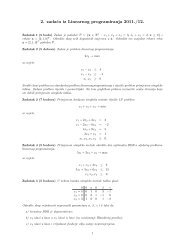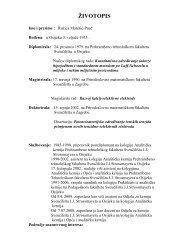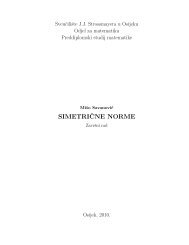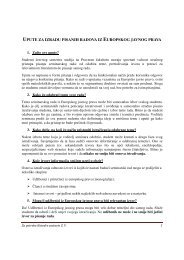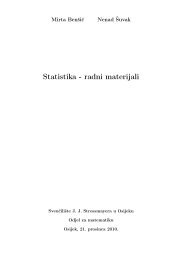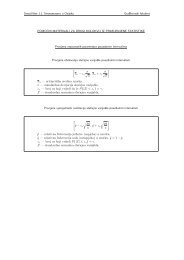Theta lifts of strongly positive discrete series: the case of (˜ Sp(n),O(V ))
Theta lifts of strongly positive discrete series: the case of (˜ Sp(n),O(V ))
Theta lifts of strongly positive discrete series: the case of (˜ Sp(n),O(V ))
Create successful ePaper yourself
Turn your PDF publications into a flip-book with our unique Google optimized e-Paper software.
GL(n j ) × <strong>Sp</strong>(n − |s|, F ), where |s| = m = ∑ ji=1 n i. Then <strong>the</strong> standardparabolic subgroup <strong>˜</strong>P s <strong>of</strong> <strong>˜</strong><strong>Sp</strong>(n) is <strong>the</strong> preimage <strong>of</strong> P s in <strong>˜</strong><strong>Sp</strong>(n). We have <strong>the</strong>analogous notation for <strong>the</strong> Levi subgroups <strong>of</strong> <strong>the</strong> metaplectic groups, whichare described in more detail in Section 2.2 <strong>of</strong> [5]. The standard parabolicsubgroups (containing <strong>the</strong> upper triangular Borel subgroup) <strong>of</strong> O(V r ) have<strong>the</strong> analogous description as <strong>the</strong> standard parabolic subgroups <strong>of</strong> <strong>Sp</strong>(n, F ). If<strong>˜</strong>P s is a standard parabolic subgroup <strong>of</strong> <strong>˜</strong><strong>Sp</strong>(n) described above, or P s a similarstandard parabolic subgroup <strong>of</strong> O(V r ), <strong>the</strong> normalized Jacquet module <strong>of</strong> asmooth representation σ <strong>of</strong> <strong>˜</strong><strong>Sp</strong>(n) (resp., O(V r )) with respect to <strong>˜</strong>P s (resp., P s )is denoted by R fP s(σ) (resp., R Ps (σ)). From now on, R P1 (π)(χ) (or R fP 1(π)(χ))stands for <strong>the</strong> isotypic component <strong>of</strong> R P1 (π) along <strong>the</strong> generalized characterχ.Also, when dealing with Jacquet modules <strong>of</strong> ω n,r , we write shortly R P1 (ω n,r )(resp., R eP 1(ω n,r )) for R<strong>˜</strong><strong>Sp</strong>(n)×P1(ω n,r ) (resp., R eP 1 ×O(V m) (ω n,r)), following <strong>the</strong>notation from [6].For any irreducible representation π ∈ S ′ (n) <strong>the</strong>re exist an ordered partitions = (n 1 , n 2 , . . . , n j ) <strong>of</strong> some m ≤ n, cuspidal representations ρ i ∈Irr(R ′ (n i )) and π cusp ∈ S ′ (n − |s|) such that π is an irreducible subquotient<strong>of</strong> <strong>the</strong> induced representation ρ 1 × ρ 2 × · · · × ρ j ⋊ π cusp . In this situation, wewrite [π] = [ρ 1 , ρ 2 , . . . , ρ j ; π cusp ], following <strong>the</strong> notation used in [8].Let σ ∈ S ′ (n) denote an irreducible representation. To simplify notation,set P ′ s = P s in orthogonal <strong>case</strong> and P ′ s = <strong>˜</strong>P s in <strong>the</strong> metaplectic one. Weintroduce µ ∗ (σ) ∈ R ′ ⊗ S ′ byµ ∗ (σ) =n∑s.s.(P (k)(σ)),′k=0where s.s. denotes <strong>the</strong> semisimplification. We extend µ ∗ linearly to <strong>the</strong> whole<strong>of</strong> S ′ .In <strong>the</strong> following lemma we recall useful formula for calculations withJacquet modules which is valid in both orthogonal and metaplectic <strong>case</strong>([20, 5]). Let α ′ = α in <strong>the</strong> metaplectic <strong>case</strong>, while in <strong>the</strong> orthogonal <strong>case</strong> α ′denotes a trivial character.Lemma 2.1. Let ρ ∈ R ′ be an irreducible cuspidal representation and a, b ∈R such that a + b ∈ Z ≥0 . Let σ ∈ S ′ be an admissible representation <strong>of</strong> finite6
length. Write µ ∗ (σ) = ∑ π,σ ′ π ⊗ σ ′ . Then <strong>the</strong> following holds:µ ∗ (δ([ν −a ρ, ν b ρ]) ⋊ σ) =We omit δ([ν x ρ, ν y ρ]) if x > y.b∑i=−a−1 j=ib∑ ∑π,σ ′ δ([ν −i α ′<strong>˜</strong>ρ, ν a α ′<strong>˜</strong>ρ]) × δ([ν j+1 ρ, ν b ρ]) × π⊗ δ([ν i+1 ρ, ν j ρ]) ⋊ σ ′ . (1)We take a moment to recall <strong>the</strong> formulation <strong>of</strong> <strong>the</strong> second Frobeniusisomorphism.Generally, for some reductive group G ′ , its parabolic subgroup P ′ with <strong>the</strong>Levi subgroup M ′ and opposite parabolic subgroup P ′ , <strong>the</strong> second Frobeniusisomorphism isHom G ′(Ind G′M ′(π), Π) ∼ = Hom M ′(π, R P ′(Π)),for some smooth representation π (resp., Π) <strong>of</strong> <strong>the</strong> group M ′ (resp., G ′ ). Wedenote <strong>the</strong> space <strong>of</strong> <strong>the</strong> representation π by V π .Above isomorphism can be explicitly described in <strong>the</strong> following way:Let Ψ denote <strong>the</strong> embeddingΨ : V π ↩→ R P ′(Ind G′M ′(V π)),which corresponds to <strong>the</strong> open cell P ′ P ′ in G ′ ([3]). Now, for some T ∈Hom G ′(Ind G′M ′(π), Π), compose Ψ with <strong>the</strong> corresponding mappingT P ′ : R P ′(Ind G′M ′(π)) → R P ′(Π).3 Embeddings <strong>of</strong> <strong>discrete</strong> <strong>series</strong>In this section we recall <strong>the</strong> classification <strong>of</strong> <strong>strongly</strong> <strong>positive</strong> <strong>discrete</strong> <strong>series</strong>and obtain fur<strong>the</strong>r embeddings <strong>of</strong> general <strong>discrete</strong> <strong>series</strong> which will be usedafterwards in <strong>the</strong> paper.In <strong>the</strong> following <strong>the</strong>orem we ga<strong>the</strong>r <strong>the</strong> results obtained in <strong>the</strong> Section 5 <strong>of</strong><strong>the</strong> paper [10]. The arguments used <strong>the</strong>re rely on Jacquet module methods,and build up in an essentially combinatorial way from <strong>the</strong> cuspidal reducibilityvalues. Moreover, <strong>the</strong> underlying combinatorics are essentially <strong>the</strong> samefor classical groups. Thus, our classification is valid for both metaplectic andorthogonal groups.7
Theorem 3.1. We define a collection <strong>of</strong> pairs (Jord, σ ′ ), where σ ′ is anirreducible cuspidal representation <strong>of</strong> some S ′ (n σ ′) and Jord has <strong>the</strong> followingform: Jord = ⋃ k ⋃ kii=1 j=1 {(ρ i, b (i)j )}, where• {ρ 1 , ρ 2 , . . . , ρ k } is a (possibly empty) set <strong>of</strong> mutually nonisomorphic irreducibleself-dual cuspidal representations <strong>of</strong> some R ′ (m 1 ),, R ′ (m 2 ), . . . ,R ′ (m k ) such that ν aρ iρ i ⋊ σ ′ reduces for a ρi > 0 (this defines a ρi ).• k i = ⌈a ρi ⌉, <strong>the</strong> smallest integer which is not smaller that a ρi .• For each i = 1, . . . , k, b (i)1 , . . . , b (i)k ithat a ρi − b (i)j· · · < b (i)k i.is a sequence <strong>of</strong> real numbers suchis an integer, for j = 1, 2, . . . , k i and −1 < b (i)1 < b (i)2 0, i = 1, 2, . . . , k, denote <strong>the</strong> unique <strong>positive</strong> s ∈ R such that <strong>the</strong>representation ν s ρ i ⋊ σ cusp reduces. Set k i = ⌈a ρi ⌉. For each i = 1, 2, . . . , k<strong>the</strong>re exists a unique increasing sequence <strong>of</strong> real numbers b (i)1 , b (i)2 , . . . , b (i)where a ρi − b (i)j is an integer, for j = 1, 2, . . . , k i and b (i)1 > −1, such that σis <strong>the</strong> unique irreducible subrepresentation <strong>of</strong> <strong>the</strong> induced representation(k∏ ∏k iδ([ν aρ i −ki+j ρ i , ν b(i) jρ i ])) ⋊ σ cusp .i=1 j=1Now, Jord(σ) = ⋃ k ⋃ kii=1 j=1 {(ρ i, b (i)j )} and σ′ (σ) = σ cusp .We note that results <strong>of</strong> [1] should imply that every a ρi in <strong>the</strong> previous<strong>the</strong>orem is half integral.This classification implies some interesting properties <strong>of</strong> <strong>strongly</strong> <strong>positive</strong><strong>discrete</strong> <strong>series</strong>, which are listed in <strong>the</strong> next two lemmas. We note that first<strong>of</strong> <strong>the</strong>m is Lemma 3.5 in [11].8k i,
Lemma 3.2. Let σ ∈ S ′ be a <strong>strongly</strong> <strong>positive</strong> <strong>discrete</strong> <strong>series</strong>. The σ isuniquely determined by [σ].Next result is ra<strong>the</strong>r straightforward from <strong>the</strong> mentioned classification:Lemma 3.3. Let σ ∈ S ′ denote a <strong>strongly</strong> <strong>positive</strong> <strong>discrete</strong> <strong>series</strong> and supposethat ν x ρ appears in [σ], where ρ ∈ R ′ is an irreducible unitarizable cuspidalrepresentation and |x| ≤ 1. Then <strong>the</strong> representation ν x ρ appears in [σ] withmultiplicity one. Also, if ν y ρ appears in [σ] for some y ≠ x, <strong>the</strong>n |y| > 1.Pro<strong>of</strong>. It is enough to prove <strong>the</strong> lemma for x ≥ 0, since o<strong>the</strong>rwise <strong>the</strong> sameconclusion can be drawn for |x|.We write σ as <strong>the</strong> unique irreducible subrepresentation <strong>of</strong> <strong>the</strong> induced representation<strong>of</strong> <strong>the</strong> form ( ∏ k ∏ kii=1 j=1 δ([νaρ i −ki+j ρ i , ν b(i) jρ i ]))⋊σ cusp . Obviously,ρ is isomorphic to ρ l for some l ∈ {1, 2, . . . , k}.By <strong>the</strong> assumption <strong>of</strong> lemma, <strong>the</strong>re is some j ∈ {1, 2, . . . , k l } such thata ρl −k l +j ≤ x ≤ b (l)j . Strong positivity <strong>of</strong> σ implies x > 0. Since a ρ l−k l +j >1 for j ≥ 2, it follows that ν x ρ appears in <strong>the</strong> segment [ν aρ l −kl+1 ρ l , ν b(l) 1 ρl ]and ν x ρ does not appear in [ν aρ l −kl+j ρ l , ν b(l) j ρl ], for j ≥ 2. Fur<strong>the</strong>r, usingx − 1 ≤ 0 we obtain x = a ρl − k l + 1.Consequently, ν x ρ appears in [σ] with multiplicity one.The inequality |y| > 1 for y ≠ x such that ν y ρ appears in [σ] is a consequence<strong>of</strong> <strong>the</strong> fact that |y| − x is a <strong>positive</strong> integer and x > 0.The principal significance <strong>of</strong> <strong>the</strong> following lemma is that it allows us toobtain certain embeddings <strong>of</strong> general <strong>discrete</strong> <strong>series</strong>.Lemma 3.4. Suppose that π ∈ S ′ (n) is an irreducible representation, whichis not in <strong>the</strong> <strong>discrete</strong> <strong>series</strong>. Then <strong>the</strong>re exists an embedding <strong>of</strong> <strong>the</strong> formπ ↩→ δ([ν a ρ, ν b ρ]) ⋊ π ′ ,where a + b ≤ 0, ρ ∈ R ′ and π ′ ∈ S ′ are irreducible representations.Pro<strong>of</strong>. We adopt <strong>the</strong> approach from <strong>the</strong> Section 3 <strong>of</strong> [10], which was motivatedby [16]. Suppose thatπ ↩→ ρ 1 × ρ 2 × · · · × ρ k ⋊ π cuspis an embedding <strong>of</strong> <strong>the</strong> representation π contradicting Casselman’s squareintegrabilitycriterium (whose metaplectic version is written in non-published9
where each ρ i ∈ R ′ is an irreducible cuspidal representation and σ cusp ∈ S ′ (n ′ )is a partial cuspidal support <strong>of</strong> σ, and consider all possible embeddings <strong>of</strong><strong>the</strong> formσ ↩→ δ(∆ 1 ) × δ(∆ 2 ) × · · · × δ(∆ m ) ⋊ σ cusp ,where ∆ 1 + ∆ 2 + · · · + ∆ m = {ρ 1 , ρ 2 , . . . , ρ l }, viewed as <strong>the</strong> equality <strong>of</strong> multisets.In <strong>the</strong> same way as in <strong>the</strong> pro<strong>of</strong> <strong>of</strong> <strong>the</strong> previous lemma, to every suchembedding we attach an element <strong>of</strong> R n−n′ and denote byσ ↩→ δ(∆ ′ 1) × δ(∆ ′ 2) × · · · × δ(∆ ′ m ′) ⋊ σ cusp (2)minimal such embedding with respect to <strong>the</strong> lexicographic ordering on R n−n′ .Analysis similar to that in <strong>the</strong> pro<strong>of</strong> <strong>of</strong> Theorem 3.3 from [10] shows e(∆ ′ 1) ≤e(∆ ′ 2) ≤ · · · ≤ e(∆ ′ m ′).Write each element <strong>of</strong> <strong>the</strong> multiset {ρ 1 , ρ 2 , . . . , ρ l } in a form ρ i = ν a iρ i,u ,where ρ i,u is an irreducible unitary cuspidal representation. Define a =min{a i : 1 ≤ i ≤ l}. The assumption that σ is not <strong>strongly</strong> <strong>positive</strong> yieldsa ≤ 0. Suppose that ν a ρ appears in <strong>the</strong> segment ∆ ′ i, with i minimal (forappropriate ρ). Then ∆ ′ i = [ν a ρ, ν b ρ], for some b.If <strong>the</strong> segment ∆ ′ i is not connected in <strong>the</strong> sense <strong>of</strong> Zelevinsky with any <strong>of</strong><strong>the</strong> segments ∆ ′ 1, . . . , ∆ ′ i−1, we obtain <strong>the</strong> embeddingσ ↩→ δ(∆ ′ i) × δ(∆ ′ 1) × · · · × δ(∆ ′ m ′) ⋊ σ cusp.Suppose that <strong>the</strong>re is some segment ∆ ′ j, 1 ≤ j ≤ i−1, such that <strong>the</strong> segments∆ ′ i and ∆ ′ j are connected in <strong>the</strong> sense <strong>of</strong> Zelevinsky. We choose largest such jand denote it with j again. Also, we write ∆ ′ j = [ν a′ ρ, ν b′ ρ]. The intertwiningoperator δ(∆ ′ j) × δ(∆ ′ i) → δ(∆ ′ i) × δ(∆ ′ j) gives <strong>the</strong> following mapsσ ↩→ δ(∆ ′ 1) × · · · × δ(∆ ′ j) × δ(∆ ′ i) × · · · × δ(∆ ′ m ′) ⋊ σ cusp→ δ(∆ ′ 1) × · · · × δ(∆ ′ i) × δ(∆ ′ j) × · · · × δ(∆ ′ m ′) ⋊ σ cusp.Observe that <strong>the</strong> kernel <strong>of</strong> previous intertwining operator equals δ(∆ ′ 1) ×· · ·×δ([ν a ρ, ν b′ ρ])×δ([ν a′ ρ, ν b ρ])×· · ·×δ(∆ ′ m ′)⋊σ cusp. Since e(∆ ′ j) ≤ e(∆ ′ i),<strong>the</strong> inequality a < a ′ implies e([ν a ρ, ν b′ ρ]) < e(∆ ′ j). Thus, minimality <strong>of</strong><strong>the</strong> embedding (2) shows that σ is not contained in <strong>the</strong> kernel <strong>of</strong> observedintertwining operator, which givesσ ↩→ δ(∆ ′ 1) × · · · × δ(∆ ′ i) × δ(∆ ′ j) × · · · × δ(∆ ′ m ′) ⋊ σ cusp.11
Repeated application <strong>of</strong> <strong>the</strong> above procedure enables us to obtain <strong>the</strong>embeddingσ ↩→ δ(∆ ′ i) × δ(∆ ′ 1) × · · · × δ(∆ ′ m ′) ⋊ σ cusp.Lemma 3.2 from [13] implies that <strong>the</strong>re is some irreducible representationσ 1 such that σ ↩→ δ([ν a ρ, ν b ρ])⋊σ 1 . Square-integrability <strong>of</strong> σ shows a+b > 0.We claim that σ 1 is a <strong>discrete</strong> <strong>series</strong> representation.Suppose on <strong>the</strong> contrary that σ 1 is not in <strong>the</strong> <strong>discrete</strong> <strong>series</strong>. Then previouslemma shows that it can be written as a subrepresentation <strong>of</strong> <strong>the</strong> inducedrepresentation <strong>of</strong> <strong>the</strong> form δ([ν x ρ ′ , ν y ρ ′ ]) ⋊ σ ′ 1, where x + y ≤ 0. Thus,σ ↩→ δ([ν a ρ, ν b ρ])×δ([ν x ρ ′ , ν y ρ ′ ])⋊σ ′ 1. Square-integrability <strong>of</strong> <strong>the</strong> representationsσ shows that <strong>the</strong> segments [ν a ρ, ν b ρ] and [ν x ρ ′ , ν y ρ ′ ] are connected in <strong>the</strong>sense <strong>of</strong> Zelevinsky, and consequently σ ↩→ δ([ν a ρ, ν y ρ]) × δ([ν x ρ ′ , ν b ρ ′ ]) ⋊ σ ′ 1.The choice <strong>of</strong> a shows that a ≤ x, which leads to a + y ≤ x + y ≤ 0,i.e., e([ν a ρ, ν y ρ]) ≤ 0, contradicting square-integrability <strong>of</strong> σ. In this way wehave proved that σ 1 is also a <strong>discrete</strong> <strong>series</strong> representation.We continue in this fashion to obtain that ei<strong>the</strong>r σ 1 is <strong>strongly</strong> <strong>positive</strong>or it can be written as a subrepresentation <strong>of</strong> <strong>the</strong> induced representation <strong>of</strong><strong>the</strong> form δ(ν a′ ρ ′ , ν b′ ρ ′ ]) ⋊ σ 2 , where a ′ ≤ 0 and σ 2 ∈ S ′ is a <strong>discrete</strong> <strong>series</strong>representations. Repeating this procedure, after a finite number <strong>of</strong> steps weobtain <strong>the</strong> claim <strong>of</strong> <strong>the</strong> <strong>the</strong>orem.4 Howe’s correspondence and results <strong>of</strong> Gan& Savin and <strong>of</strong> KudlaIn this section we review some results about Howe correspondence.For an irreducible genuine smooth representation σ ∈ S 2 (n), let Θ(σ, r)be a smooth representation <strong>of</strong> O(V r ), given as <strong>the</strong> full lift <strong>of</strong> σ to <strong>the</strong> r-level<strong>of</strong> <strong>the</strong> orthogonal tower, i.e., <strong>the</strong> biggest quotient <strong>of</strong> ω n,ron which <strong>˜</strong><strong>Sp</strong>(n)acts as a multiple <strong>of</strong> σ. As a representation <strong>of</strong> <strong>˜</strong><strong>Sp</strong>(n) × O(V r ) it has a formσ ⊗ Θ(σ, r). We write Θ + (σ, r) (resp., Θ − (σ, r)) for <strong>the</strong> lift on <strong>the</strong> +–tower(resp., −–tower), when emphasizing <strong>the</strong> tower.Similarly, if τ is an irreducible representation <strong>of</strong> O(V r ), <strong>the</strong>n one has itsfull lift Θ(τ, n), which is a smooth representation <strong>of</strong> <strong>˜</strong><strong>Sp</strong>(n).12
<strong>the</strong> representation ν s 2χ V,ψ ⋊ σ cusp reduces for s 2 = |m r ′ − n ′ − 1|, wherem r ′ = 1 2 dimV r ′.We take a moment to state <strong>the</strong> results from <strong>the</strong> Section 2 <strong>of</strong> <strong>the</strong> paper[7], which happen to be crucial for our investigation.Theorem 4.3. Let τ ∈ S 1 (r) denote an irreducible representation and suppose[τ] = [ρ 1 , ρ 2 , . . . , ρ k ; τ cusp ], with τ cusp ∈ S 1 (r ′ ) being an irreducible cuspidalrepresentation. Let σ cusp = τ(n ′ ) be <strong>the</strong> first non-zero lift <strong>of</strong> <strong>the</strong> representationτ cusp , observe that σ cusp ∈ S 2 (n ′ ) is an irreducible cuspidal representation.Let σ denote an irreducible quotient <strong>of</strong> Θ(τ, n). We have <strong>the</strong> followingpossibilities:• If n ≥ n ′ +r−r ′ , <strong>the</strong>n [σ] = [χ V,ψ ν mr−n , χ V,ψ ν mr−n+1 , . . . , χ V,ψ ν m r ′−n′ −1 ,χ V,ψ ρ 1 , χ V,ψ ρ 2 , . . . , χ V,ψ ρ k ; σ cusp ],• If n < n ′ + r − r ′ , set t = r − r ′ − n + n ′ . Then <strong>the</strong>re exist i 1 , i 2 , . . . , i t ∈{1, 2, . . . , k} such that ρ ij = ν mr−n−j for j = 1, 2, . . . , t and [σ] =[χ V,ψ ρ 1 , . . . , ̂χ V,ψ ρ i1 , . . . , ̂χ V,ψ ρ it , . . . , χ V,ψ ρ k ; σ cusp ], where ̂χ V,ψ ρ i meansthat we omit χ V,ψ ρ i .Similarly, let σ ∈ S 2 (n) denote an irreducible representation and suppose[σ] = [χ V,ψ ρ 1 , χ V,ψ ρ 2 , . . . , χ V,ψ ρ k ; σ cusp ], with σ cusp ∈ S 2 (n ′ ) being an irreduciblecuspidal representation. Let τ cusp = σ(r ′ ) be <strong>the</strong> first non-zero lift <strong>of</strong><strong>the</strong> representation σ cusp , observe that τ cusp ∈ S 1 (r ′ ) is an irreducible cuspidalrepresentation. Let τ denote an irreducible quotient <strong>of</strong> Θ(σ, r). We have <strong>the</strong>following possibilities:• If r ≥ r ′ +n−n ′ , <strong>the</strong>n [τ] = [ν mr−n−1 , ν mr−n−2 , . . . , ν m r ′−n′ , ρ 1 , ρ 2 , . . . , ρ k ;τ cusp ],• If r < r ′ + n − n ′ , set t = r ′ − n ′ + n − r. Then <strong>the</strong>re exist i 1 , i 2 , . . . , i t ∈{1, 2, . . . , k} such that ρ ij = ν mr−n+j−1 for j = 1, 2, . . . , t and [τ] =[ρ 1 , . . . , ̂ρ i1 , . . . , ̂ρ it , . . . , ρ k ; τ cusp ], where ̂ρ i means that we omit ρ i .The next <strong>the</strong>orem that we need is Kudla’s filtration <strong>of</strong> Jacquet modules<strong>of</strong> <strong>the</strong> oscillatory representation ([7, Theorem 2.8]):Theorem 4.4. Let ω n,r denote <strong>the</strong> oscillatory representation <strong>of</strong> <strong>the</strong> group<strong>˜</strong><strong>Sp</strong>(n) × O(V r ) corresponding to <strong>the</strong> non-trivial additive character ψ. Thefollowing holds:14
• Let P j denote <strong>the</strong> standard maximal parabolic subgroup <strong>of</strong> O(V r ). ThenJacquet module R Pj (ω n,r ) has <strong>˜</strong><strong>Sp</strong>(n) × M j -invariant filtration given byI jk , 0 ≤ k ≤ j, whereI jk ≃ Ind<strong>˜</strong><strong>Sp</strong>(n)×M jP jk × fP k ×O(V r−j ) (γ jk ⊗ Σ ′ k ⊗ ω n−k,r−j ).Here, P jk is a standard parabolic subgroup <strong>of</strong> GL(j, F ) which correspondsto <strong>the</strong> partition (j − k, k), γ jk is a character <strong>of</strong> GL(j − k, F ) ×GL(k, <strong>˜</strong>F ) given byj−k+1−(mr−n−γ jk (g 1 , g 2 ) = ν 2 ) (g 1 )χ V,ψ (g 2 ),and Σ ′ k is a twist <strong>of</strong> <strong>the</strong> standard representation <strong>of</strong> GL(k, F )×GL(k, F )on <strong>the</strong> space <strong>of</strong> smooth locally constant compactly supported complexvalued functions Cc ∞ (GL(k, F )):Σ ′ k(g 1 , g 2 )f(g) = ν −(m r−j+ k−12 ) ν m r−j+ k−12 f(g−11 gg 2 ).j+1−(mr−n−Especially, a quotient I j0 equals ν 2 ) ⊗ ω n,r−j and a subrepresentationI jj equals Ind<strong>˜</strong><strong>Sp</strong>(n)×M jGL(j,F )× fP j ×O(V r−j ) (χ V,ψ ⊗ Σ ′ j ⊗ ω n−j,r−j ).• Let <strong>˜</strong>P j denote <strong>the</strong> standard maximal parabolic subgroup <strong>of</strong> <strong>˜</strong><strong>Sp</strong>(n). ThenJacquet module R fP j(ω n,r ) has <strong>˜</strong>M j × O(V r )-invariant filtration given byJ jk , 0 ≤ k ≤ j, wherefMJ jk ≃ Indj ×O(V r)(β gP jk ×P k × <strong>Sp</strong>(n−j) <strong>˜</strong> jk ⊗ Σ ′ k ⊗ ω n−j,r−k ).Here, <strong>˜</strong>Pjk is a standard parabolic subgroup <strong>of</strong> GL(j, <strong>˜</strong> F ) which correspondsto <strong>the</strong> partition (j − k, k), β jk is a character <strong>of</strong> GL(j <strong>˜</strong> − k, F ) ×GL(k, <strong>˜</strong>F ) given byj−k−1mr−n−β jk (g 1 , g 2 ) = (χ V,ψ ν 2 )(g 1 )χ V,ψ (g 2 ),and Σ ′ k is a twist <strong>of</strong> <strong>the</strong> standard representation <strong>of</strong> GL(k, F )×GL(k, F )on <strong>the</strong> space <strong>of</strong> smooth locally constant compactly supported complexvalued functions Cc ∞ (GL(k, F )):Σ ′ k+1mr+k(g 1 , g 2 )f(g) = ν 2 ν−(m r+ k+12 ) f(g1 −1 gg 2 ).15
j−1mr−n+Especially, a quotient J j0 equals χ V,ψ ν 2 ⊗ ω n−j,r and a subrepresentationJ jj equals IndfM j ×O(V r)GL(j,F <strong>˜</strong> )×P j × <strong>˜</strong>5 Some technical results on <strong>lifts</strong><strong>Sp</strong>(n−j) (χ V,ψ ⊗ Σ ′ j ⊗ ω n−j,r−j ).The purpose <strong>of</strong> this section is to state and prove many technical results whichwill be <strong>of</strong> particular importance in <strong>the</strong> following sections.An elementary but useful criterion for pushing down <strong>the</strong> <strong>lifts</strong> <strong>of</strong> irreduciblerepresentations is established by <strong>the</strong> following two propositions.Proposition 5.1. Let τ ∈ S 1 (r) be an irreducible representation. Then <strong>the</strong>following hold:1. Suppose that Θ(τ, n) ≠ 0. Then R fP 1(Θ(τ, n + 1))(χ V,ψ ν mr−(n+1) ) ≠ 0.2. Suppose that R P1 (τ)(ν mr−(n+1) ) = 0. Then Θ(τ, n) ≠ 0 if and only ifR fP 1(Θ(τ, n + 1))(χ V,ψ ν mr−(n+1) ) ≠ 0.Pro<strong>of</strong>. The pro<strong>of</strong> follows <strong>the</strong> same lines as that <strong>of</strong> Theorem 4.5 <strong>of</strong> [6].Assume that Θ(τ, n) ≠ 0. Then <strong>the</strong>re exists an epimorphism ω n,r →τ ⊗ Θ(τ, n). Kudla’s filtration gives <strong>the</strong> epimorphismsR fP 1(ω n+1,r ) → χ V,ψ ν mr−(n+1) ⊗ ω n,r → χ V,ψ ν mr−(n+1) ⊗ τ ⊗ Θ(τ, n).Using Frobenius reciprocity we get a non-trivial intertwining Θ(τ, n + 1) →χ V,ψ ν mr−(n+1) ⋊ Θ(τ, n). This obviously proves <strong>the</strong> first statement <strong>of</strong> <strong>the</strong>proposition.It remains to prove sufficiency in <strong>the</strong> second statement. The conditionR fP 1(Θ(τ, n + 1))(χ V,ψ ν mr−(n+1) ) ≠ 0 gives Θ(τ, n + 1) ≠ 0, that gives anepimorphism ω n+1,r → τ ⊗ Θ(τ, n + 1). Applying Jacquet modules, we getan epimorphism R fP 1(ω n+1,r ) → τ ⊗ χ V,ψ ν mr−(n+1) ⊗ σ ′ for some irreduciblerepresentation σ ′ ∈ S 1 (n). If we suppose that <strong>the</strong> restriction <strong>of</strong> this epimorphismto a subrepresentation J 11 is non-zero, second Frobenius reciprocitygives a non-zero intertwining mapχ V,ψ ⊗ Σ ′ 1 ⊗ ω n,r−1 → <strong>˜</strong>R P1 (<strong>˜</strong>τ) ⊗ χ V,ψ ν mr−(n+1) ⊗ σ ′ .From this intertwining we deduce τ ↩→ ν mr−(n+1) ⋊ τ ′ , for some irreduciblerepresentation τ ′ ∈ S 2 (r − 1), contradicting <strong>the</strong> assumption <strong>of</strong> proposition.Consequently, <strong>the</strong>re exists a non-zero intertwining J 10 → τ ⊗χ V,ψ ν mr−(n+1) ⊗σ ′ , which gives Θ(τ, n) ≠ 0.16
We omit <strong>the</strong> pro<strong>of</strong> <strong>of</strong> <strong>the</strong> next proposition since it is completely analogousto <strong>the</strong> pro<strong>of</strong> <strong>of</strong> <strong>the</strong> previous one.Proposition 5.2. Let σ ∈ S 2 (n) be an irreducible representation. Then <strong>the</strong>following hold:1. Suppose that Θ(σ, r) ≠ 0. Then R P1 (Θ(σ, r + 1))(ν −(m r+1−n−1) ) ≠ 0.2. Suppose that R fP 1(σ)(χ V,ψ ν −(m r+1−n−1) ) = 0. Then Θ(σ, r) ≠ 0 if andonly if R P1 (Θ(σ, r + 1))(ν −(m r+1−n−1) ) ≠ 0.Now we prove an important result regarding <strong>the</strong> square-integrability <strong>of</strong><strong>the</strong> <strong>lifts</strong> <strong>of</strong> <strong>strongly</strong> <strong>positive</strong> <strong>discrete</strong> <strong>series</strong>. In particular, this result gives analternative and essentially combinatorial pro<strong>of</strong> <strong>of</strong> a special <strong>case</strong> <strong>of</strong> <strong>the</strong> results<strong>of</strong> [17].Proposition 5.3. Let σ ∈ S 2 (n) denote a <strong>strongly</strong> <strong>positive</strong> <strong>discrete</strong> <strong>series</strong>.Suppose that Θ(σ, r) ≠ 0, for some r such that m r ≤ n + 1 2 , andR fP 1(σ)(χ V,ψ ν −(m k−n−1) ) = 0 for k ≥ r + 1. Then σ(r) is a <strong>discrete</strong> <strong>series</strong>representation.Pro<strong>of</strong>. We prove this proposition by downwards induction on r, starting withan r such that m r = n + 1. If m 2 r = n + 1 , Theorem 4.2 shows our claim.2Thus, suppose that <strong>the</strong> claim holds for some r + 1 such that m r+1 ≤ n + 1.2We prove it for r.It may be easily concluded from <strong>the</strong> pro<strong>of</strong> <strong>of</strong> Lemma 5.1 (in <strong>the</strong> same wayas in <strong>the</strong> pro<strong>of</strong> <strong>of</strong> Lemma 5.1 from [15]) that <strong>the</strong>re is a non-zero intertwiningσ(r) ↩→ ν −(mr−n−1) ⋊ σ(r − 1).Note that in our <strong>case</strong> m r < n + 1, which implies −(m 2 r − n − 1) ≥ 3.2Now, suppose that σ(r − 1) is not a <strong>discrete</strong> <strong>series</strong> representation. Accordingto Lemma 3.4, <strong>the</strong>re is an embedding σ(r − 1) ↩→ δ([ν a ρ, ν b ρ]) ⋊ σ ′ , wherea + b ≤ 0. Obviously, a ≤ 0.Since m r − n − 1 ≤ − 3 , strong positivity <strong>of</strong> <strong>the</strong> representation σ and2Lemma 3.3 toge<strong>the</strong>r with Theorem 4.3 imply <strong>the</strong>re is at most one x ∈ R,0 < |x| ≤ 1 such that ν x ρ appears in [σ(r − 1)]. Therefore, b ≤ 0 and<strong>the</strong> representation ν −(mr−n−1) × ν b ρ is irreducible and isomorphic to ν b ρ ×ν −(mr−n−1) .We thus get <strong>the</strong> following embeddings and isomorphisms:σ(r) ↩→ ν −(mr−n−1) ⋊ σ(r − 1) ↩→ ν −(mr−n−1) × δ([ν a ρ, ν b ρ]) ⋊ σ ′↩→ ν −(mr−n−1) × ν b ρ × δ([ν a ρ, ν b−1 ρ]) ⋊ σ ′≃ ν b ρ × ν −(mr−n−1) × δ([ν a ρ, ν b−1 ρ]) ⋊ σ ′ ,17
contradicting square-integrability <strong>of</strong> σ(r). This proves <strong>the</strong> proposition.In pretty much <strong>the</strong> same way one can also proveCorollary 5.4. Let τ ∈ S 1 (r) denote a <strong>strongly</strong> <strong>positive</strong> <strong>discrete</strong> <strong>series</strong>.Suppose that Θ(τ, n) ≠ 0, for some n such that m r ≥ n + 1 . Then τ(n) is a2<strong>discrete</strong> <strong>series</strong> representation.The last two propositions <strong>of</strong> this section contain ra<strong>the</strong>r important resulton <strong>the</strong> transfer <strong>of</strong> certain embeddings by <strong>the</strong> <strong>the</strong>ta <strong>lifts</strong>. We omit <strong>the</strong> pro<strong>of</strong>s,since this results can be obtained in completely analogous way as in [15,Remark 5.2], i.e., by precise examination <strong>of</strong> <strong>the</strong> filtration <strong>of</strong> Jacquet modulesquoted in <strong>the</strong> Theorem 4.4.Proposition 5.5. Suppose that <strong>the</strong> representation σ ∈ Irr(<strong>˜</strong><strong>Sp</strong>(n)) may bewritten as an irreducible subrepresentation <strong>of</strong> <strong>the</strong> induced representation <strong>of</strong><strong>the</strong> form δ([ν a ρ, ν b ρ]) ⋊ σ ′ , where ρ is an irreducible cuspidal genuine representation,σ ′ ∈ Irr( <strong>˜</strong><strong>Sp</strong>(n ′ )) and b − a ≥ 0. Let Θ(σ, r) ≠ 0. Then one <strong>of</strong> <strong>the</strong>following hold:• There is an irreducible representation τ <strong>of</strong> some O(V r ′) such that σ(r)is a subrepresentation <strong>of</strong> δ([ν a χ −1V,ψ ρ, νb χ −1V,ψρ]) ⋊ τ.• There is an irreducible representation τ <strong>of</strong> some O(V r ′) such that σ(r)is a subrepresentation <strong>of</strong> δ([ν a+1 χ −1V,ψ ρ, νb χ −1V,ψρ]) ⋊ τ.The latter situation is impossible unless (a, ρ) = (m r − n, χ V,ψ ).Proposition 5.6. Suppose that <strong>the</strong> representation τ ∈ Irr(O(V r )) may bewritten as an irreducible subrepresentation <strong>of</strong> <strong>the</strong> induced representation <strong>of</strong><strong>the</strong> form δ([ν a ρ, ν b ρ]) ⋊ τ ′ , where ρ is an irreducible cuspidal representation,τ ′ ∈ Irr(O(V r ′)) and b − a ≥ 0. Let Θ(τ, n) ≠ 0. Then one <strong>of</strong> <strong>the</strong> followingholds:• There is an irreducible representation σ <strong>of</strong> some <strong>˜</strong><strong>Sp</strong>(n ′ ) such that τ(n)is a subrepresentation <strong>of</strong> δ([ν a χ V,ψ ρ, ν b χ V,ψ ρ]) ⋊ σ.• There is an irreducible representation σ <strong>of</strong> some <strong>˜</strong><strong>Sp</strong>(n ′ ) such that τ(n)is a subrepresentation <strong>of</strong> δ([ν a+1 χ V,ψ ρ, ν b χ V,ψ ρ]) ⋊ σ.The latter situation is impossible unless (a, ρ) = (n − m r + 1, 1 F ×).18
Observe that Proposition 5.2 implies that <strong>the</strong> representation σ(l) is nota <strong>discrete</strong> <strong>series</strong> representation for l > r.There are two main <strong>case</strong>s which we consider.Suppose that <strong>the</strong> representation χ V,ψ ν 1 2 does not appear in [σ]. Sincem r − n = 1, Theorem 4.3 yields 2 n′ ≥ r ′ + 1(dim(V ɛ2 0 ) − 1). We have twopossibilities:• n ′ = r ′ + 1 2 (dim(V ɛ0 ) − 1)In this <strong>case</strong> both representation χ V,ψ ν s ⋊σ cusp and ν s ⋊τ cusp reduce for s =1. Therefore, by Theorem 3.1, <strong>the</strong>re is no representations <strong>of</strong> <strong>the</strong> form χ 2 ,ψν sappearing in [σ]. Fur<strong>the</strong>r, Theorem 3.5 <strong>of</strong> [6] implies that <strong>the</strong> representationχ V,ψ ν s ρ i ⋊ σ cusp reduces if and only if <strong>the</strong> representation ν s ρ i ⋊ τ cusp reduces.One <strong>of</strong> <strong>the</strong> main results <strong>of</strong> <strong>the</strong> paper [4] states that σ(r) is a <strong>discrete</strong> <strong>series</strong>representation. Applying Theorem 2 we obtain <strong>the</strong> embeddingσ(r) ↩→ δ([ν a 1ρ ′ 1, ν b 1ρ ′ 1]) × δ([ν a 2ρ ′ 2, ν b 2ρ ′ 2]) × · · · × δ([ν a lρ ′ l, ν b lρ ′ l]) ⋊ τ sp ,where a i ≤ 0 and ρ ′ i ∈ {ρ 1 , ρ 2 , . . . , ρ k } for i = 1, 2, . . . , l, and τ sp ∈ Irr(O(V ɛr ′))a <strong>strongly</strong> <strong>positive</strong> <strong>discrete</strong> <strong>series</strong>, for some r ′ .Since <strong>the</strong> representation σ is <strong>strongly</strong> <strong>positive</strong>, Theorem 4.3 and Lemma3.3 show that for every i ∈ {1, 2, . . . , k} <strong>the</strong>re is at most one representation<strong>of</strong> <strong>the</strong> form ν x ρ i that appears in [σ(r)] with 0 ≤ |x| < 1. In <strong>the</strong> same way asin <strong>the</strong> pro<strong>of</strong> <strong>of</strong> Proposition 5.3 we deduce σ(r) ≃ τ sp , i.e., σ(r) is a <strong>strongly</strong><strong>positive</strong> representation.It is now easy to see, using Lemma 3.2, that σ(r) is unique irreduciblesubrepresentation <strong>of</strong> <strong>the</strong> induced representation(k∏ ∏k iδ([ν aρ i −ki+j ρ i , ν b(i) jρ i ])) ⋊ τ cusp .i=1 j=1Suppose that Θ(σ, r−1) ≠ 0. Then Proposition 5.2 implies R P1 (Θ(σ, r))(ν 1 2 ) ≠0, which is impossible. Thus, r is <strong>the</strong> first occurrence index <strong>of</strong> σ.• n ′ > r ′ + 1 2 (dim(V ɛ0 ) − 1)20
In this <strong>case</strong>, <strong>the</strong> representation χ V,ψ ν s ⋊σ cusp reduces for s = n ′ −m r ′ +1,and <strong>the</strong> representation ν s ⋊ τ cusp reduces for s = n ′ − m r ′.Observe that [σ(r)] is obtained from [σ] by multiplying with χ −1V,ψall representations<strong>of</strong> <strong>the</strong> form χ V,ψ ν x ρ i appearing in [σ], adding <strong>the</strong> representationsν − 1 2 , ν − 3 2 , . . . , ν m r ′−n′ and replacing σ cusp with τ cusp .There are two possible <strong>case</strong>s which we consider:1. Some representation <strong>of</strong> <strong>the</strong> form χ V,ψ ν s , s ∈ R, appears in [σ]: We maysuppose that ρ 1 is a trivial representation. Note that a ρ1 − k 1 + 1 isstrictly greater than 1 2 and a ρ 1equals n ′ − m r ′ + 1.For simplicity <strong>of</strong> notation, let a j stand for a ρ1 −k 1 +j, for j = 1, 2, . . . , k 1 .Again, we know that σ(r) is a <strong>discrete</strong> <strong>series</strong> representation. Inspectingits cuspidal support more precisely, it is not hard to see that it has to be<strong>strongly</strong> <strong>positive</strong>. Using Lemma 3.2 we get that σ(r) can be obtainedas <strong>the</strong> unique irreducible subrepresentation <strong>of</strong>ν 1 2 × ν32 × · · · × νa 1 −2 ×(i=2 j=1∏k 1j=1δ([ν a j−1 , ν b(1) j]))×k∏ ∏k iδ([ν aρ i −ki+j ρ i , ν b(i) jρ i ])) ⋊ τ cusp .If a 1 ≥ 5, Theorem 5.3 from [11] implies R 2 P 1(σ(r))(ν 1 2 ) ≠ 0. If a 1 = 3,2<strong>the</strong> same result shows that R P1 (σ(r))(ν 1 2 ) = 0 (since b (1)1 ≥ a 1 > 1).2Using Proposition 5.2 we conclude that Θ ɛ (σ, r − 1) ≠ 0 if a 1 ≥ 5 and 2Θ ɛ (σ, r − 1) = 0 o<strong>the</strong>rwise.If a 1 ≥ 5 , combining <strong>the</strong> square-integrability <strong>of</strong> σ(r−1) (by Proposition25.3) with <strong>the</strong> fact that [σ(r − 1)] is obtained from [σ(r)] by subtractingν 1 2 , we get that σ(r − 1) is <strong>strongly</strong> <strong>positive</strong> <strong>discrete</strong> <strong>series</strong> which canbe realized as a unique irreducible subrepresentation <strong>of</strong>ν 3 2 × ν52 × · · · × νa 1 −2 ×(i=2 j=1∏k 1j=1δ([ν a j−1 , ν b(1) j]))×k∏ ∏k iδ([ν aρ i −ki+j ρ i , ν b(i) jρ i ])) ⋊ τ cusp .21
Proceeding with <strong>the</strong> same analysis as above, we obtain that Θ ɛ (σ, r −l) ≠ 0 for l = 1, 2, . . . , r − a 1 + 3 , and σ(r − l) is a <strong>strongly</strong> <strong>positive</strong>2<strong>discrete</strong> <strong>series</strong> which can be realized as a unique irreducible subrepresentation<strong>of</strong>∏k 1ν l+ 1 2 × νl+ 3 2 × · · · × νa 1 −2 × δ([ν aj−1 , ν b(1) j])×(i=2 j=1j=1k∏ ∏k iδ([ν aρ i −ki+j ρ i , ν b(i) jρ i ])) ⋊ τ cusp .Fur<strong>the</strong>r, it is easy to check that <strong>the</strong> first occurrence index <strong>of</strong> σ equalsr − a 1 + 3 2 .2. There is no representation <strong>of</strong> <strong>the</strong> form χ V,ψ ν s , s ∈ R, appearing in[σ]: As in <strong>the</strong> previous <strong>case</strong> we conclude that σ(r) is <strong>strongly</strong> <strong>positive</strong><strong>discrete</strong> <strong>series</strong>. An easy computation shows that σ(r) is a uniqueirreducible subrepresentation <strong>of</strong> <strong>the</strong> induced representationν 1 2 × ν32 × · · · × νn ′ −m r′× (k∏ ∏k ii=1 j=1δ([ν aρ i −k i+j ρ i , ν b(i) jρ i ])) ⋊ τ cusp .Now Theorem 5.3 from [11] shows that R P1 (σ(r))(ν 1 2 ) ≠ 0. SinceR fP 1(σ)(χ V,ψ ν 1 2 ) = 0, part 2 <strong>of</strong> Proposition 5.2 implies Θ ɛ (σ, r − 1) ≠ 0.Note that [σ(r − 1)] and [σ(r)] differ by ν 1 2 . Proposition 5.3 now showsthat σ(r − 1) is a <strong>discrete</strong> <strong>series</strong> representation, and we again concludethat it must be <strong>strongly</strong> <strong>positive</strong>. Thus, σ(r −1) is a unique irreduciblesubrepresentation <strong>of</strong> <strong>the</strong> induced representationν 3 2 × ν52 × · · · × νn ′ −m r′× (k∏ ∏k ii=1 j=1δ([ν aρ i −k i+j ρ i , ν b(i) jρ i ])) ⋊ τ cusp .If n ′ −m r ′ > 1, in <strong>the</strong> same way as above we deduce 2 Θɛ (σ, r−2) ≠ 0. Wecontinue in this fashion obtaining Θ ɛ (σ, r − j) ≠ 0 for j = 1, 2, . . . , n ′ −m r ′ + 1 , while σ(r − j) is a <strong>strongly</strong> <strong>positive</strong> <strong>discrete</strong> <strong>series</strong> which can2be characterized as <strong>the</strong> unique irreducible subrepresentation <strong>of</strong>ν j+ 1 2 × νj+ 3 2 × · · · × νn ′ −m r′× (k∏ ∏k iδ([ν aρ i −ki+j ρ i , ν b(i) jρ i ])) ⋊ τ cusp .i=1 j=122
From Proposition 5.2 we conclude that <strong>the</strong> first occurrence index <strong>of</strong> σequals r − n ′ + m r ′ − 1 2 = r − (n′ − 1 2 dimV ɛr ′ + 2) + 3 2 .Second, suppose that <strong>the</strong> representation χ V,ψ ν 1 2 appears in [σ]. There isno loss <strong>of</strong> generality in assuming that ρ 1 is a trivial representation. We haveto examine <strong>the</strong> following three possibilities:• n ′ = r ′ + 1 2 (dim(V ɛ0 ) − 1)Observe that in this <strong>case</strong> both representation χ V,ψ ν s ⋊σ cusp and ν s ⋊τ cuspreduce for s = 1. Obviously, Theorem 3.1 implies k 2 1 = 1.Observe that [σ(r)] is obtained from [σ] simply by replacing σ cusp withτ cusp and multiplying all <strong>˜</strong>GL-members <strong>of</strong> [σ] with χ−1V,ψ, <strong>discrete</strong> <strong>series</strong> σ(r)may be realized as <strong>the</strong> unique irreducible subrepresentation <strong>of</strong>k∏ ∏k iδ([ν 1 2 , νb (1)1 ]) × ( δ([ν aρ i −ki+j ρ i , ν b(i) jρ i ])) ⋊ τ cusp .i=2 j=1We just note that for each i ∈ {1, 2, . . . , k} <strong>the</strong>re is at most one x ∈ R,0 ≤ |x| ≤ 1, such that ν x ρ i appears in [σ(r)], thus τ has to be <strong>strongly</strong><strong>positive</strong>.Obviously, R P1 (σ(r))(ν 1 2 ) ≠ 0 if and only if b (1)1 = 1 2 .If b (1)1 > 1 2 , using Proposition 5.2 we directly conclude Θɛ (σ, r − 1) = 0.Suppose that b (1)1 = 1 2 . If Θɛ (σ, r − 1) ≠ 0, we get that ν 1 2 does not appearin [σ(r − 1)], contradicting Proposition 5.5 (we are in <strong>the</strong> first <strong>case</strong> <strong>the</strong>re).Thus, r is <strong>the</strong> first occurrence index <strong>of</strong> σ.• n ′ < r ′ + 1 2 (dim(V ɛ0 ) − 1)In this <strong>case</strong> <strong>the</strong> representation χ V,ψ ν s ⋊ σ cusp reduces for s = m r ′ − n ′ − 1and <strong>the</strong> representation ν s ⋊ τ cusp reduces for s = m r ′ − n ′ .According to Theorem 4.3, [σ(r)] is obtained from [σ] by multiplyingwith χ −1V,ψ all <strong>˜</strong>GL-members <strong>of</strong> [σ], subtracting <strong>the</strong> representations ν 1 2 , ν 3 2 , . . . ,ν m r ′−n′ −1 and replacing σ cusp with τ cusp . In <strong>the</strong> same way as before, weconclude that σ(r) is <strong>strongly</strong> <strong>positive</strong> <strong>discrete</strong> <strong>series</strong>, which is characterizedas a unique irreducible subrepresentation <strong>of</strong>δ([ν 3 2 , νb (1)1 ]) × δ([ν52 , νb (1)2 ]) × · · · × δ([νm r ′−n ′ , ν b(1) k 1 ])×23
k∏ ∏k i( δ([ν aρ i −ki+j ρ i , ν b(i) jρ i ])) ⋊ τ cusp .i=2 j=1Since ν 1 2 does not appear in [σ(r)], it follows that r is <strong>the</strong> first occurrenceindex <strong>of</strong> σ.• n ′ > r ′ + 1 2 (dim(V ɛ0 ) − 1)Now <strong>the</strong> representation χ V,ψ ν s ⋊ σ cusp reduces for s = n ′ − m r ′ + 1, and<strong>the</strong> representation ν s ⋊ τ cusp reduces for s = n ′ − m r ′.Theorem 4.3 now shows that [σ(r)] is obtained from [σ] by multiplyingwith χ −1V,ψ all <strong>˜</strong>GL-members <strong>of</strong> [σ], adding <strong>the</strong> representations ν− 1 2 , ν − 3 2 , . . . ,ν m r ′−n′ and replacing σ cusp with τ cusp .From Theorem 4.2 we know that <strong>the</strong> representation σ(r) is in <strong>the</strong> <strong>discrete</strong><strong>series</strong>. But, ν 1 2 appears in [σ(r)] with <strong>the</strong> multiplicity two and consequentlyσ(r) can’t be a <strong>strongly</strong> <strong>positive</strong> representation (by Lemma 3.3).In <strong>the</strong> sequel, we use Theorem 3.5 to describe <strong>discrete</strong> <strong>series</strong> σ(r) asprecise as we can. So, we write σ(r) as a subrepresentation <strong>of</strong> <strong>the</strong> inducedrepresentation <strong>of</strong> <strong>the</strong> formδ([ν a′ 1 ρ′1 , ν b′ 1 ρ′1 ]) × δ([ν a′ 2 ρ′2 , ν b′ 2 ρ′2 ]) × · · · × δ([ν a′ l ρ′l , ν b′ l ρ′l ]) ⋊ τ sp ,where ρ ′ i ∈ {ρ 1 , ρ 2 , . . . , ρ k }, a ′ i ≤ 0 and a ′ i + b ′ i > 0 for i = 1, 2, . . . , l. Fur<strong>the</strong>r,τ sp is an irreducible <strong>strongly</strong> <strong>positive</strong> representation such that [τ sp ] iscontained in [σ(r)]. Hence, at least one <strong>of</strong> <strong>the</strong> representations ν 1 2 and ν − 1 2has to appear in some segment [ν a′ i ρ′i , ν b′ i ρ′i ], i ∈ {1, 2, . . . , l}. Since a ′ i ≤ 0and b ′ i > 0, both <strong>the</strong>se representations appear in this segment.Our next claim is that l = 1. Suppose, on <strong>the</strong> contrary, that l > 1.We conclude that <strong>the</strong>re is some j ∈ {1, 2, . . . , l}, j ≠ i, such thatν 1 2 /∈ [ν a′ j ρ′j , ν b′ j ρ′j ]. But, <strong>the</strong> union <strong>of</strong> <strong>the</strong> segments [ν a′ i , νb ′ i ] and [νa ′ j ρ′j , ν b′ j ρ′j ]is contained in [σ(r)], so <strong>the</strong>re is at most one x, 0 ≤ |x| ≤ 1, such thatν x ρ ′ j appears in [ν a′ j ρ′j , ν b′ j ρ′j ]. This contradicts <strong>the</strong> fact that <strong>the</strong> ends <strong>of</strong> <strong>the</strong>segment [ν a′ j ρ′j , ν b′ j ρ′j ] satisfy a ′ j ≤ 0 and b ′ j > 0. Thus, l = 1 and ρ ′ 1 ∼ = 1 F ×.In this way we obtained <strong>the</strong> following embedding:σ(r) ↩→ δ([ν a′ 1 , νb ′ 1 ]) ⋊ τsp .24
Since a ′ 1 ≤ 0, using Proposition 5.6 we obtain a contradiction with <strong>the</strong>strong positivity <strong>of</strong> σ. Therefore, this <strong>case</strong> is impossible and Theorem 6.1 isproved.We point out that <strong>the</strong> obtained results closely parallel those contained in<strong>the</strong> Theorem 4.2 <strong>of</strong> <strong>the</strong> manuscript [15] for <strong>the</strong> dual pair (<strong>Sp</strong>(n), O(V )).7 Lifts <strong>of</strong> <strong>strongly</strong> <strong>positive</strong> <strong>discrete</strong> <strong>series</strong> <strong>of</strong><strong>the</strong> orthogonal groupsThe purpose <strong>of</strong> this section is to determine <strong>the</strong> first occurrence indices <strong>of</strong><strong>strongly</strong> <strong>positive</strong> <strong>discrete</strong> <strong>series</strong> <strong>of</strong> <strong>the</strong> odd orthogonal groups which appearin <strong>the</strong> correspondence given by Theorem 4.2 and to provide a description <strong>of</strong><strong>the</strong> <strong>lifts</strong> <strong>of</strong> such representations in <strong>the</strong> metaplectic tower.Thus, we let τ ∈ Irr(O(V r )) denote a <strong>strongly</strong> <strong>positive</strong> <strong>discrete</strong> <strong>series</strong> suchthat Θ(τ, m r − 1 ) ≠ 0 and realize it as a unique irreducible subrepresentation2<strong>of</strong> <strong>the</strong> induced representation <strong>of</strong> <strong>the</strong> form(k∏ ∏k iδ([ν aρ i −ki+j ρ i , ν b(i) jρ i ])) ⋊ τ cusp ,i=1 j=1with k minimal and k i minimal for i = 1, 2, . . . , k, where τ cusp ∈ Irr(O(V r ′))is a cuspidal representation and ρ i an irreducible cuspidal representation <strong>of</strong>GL(n ρi , F ) (this defines n ρi ) for i = 1, 2, . . . , k.Note that Proposition 5.1 yields that <strong>the</strong> representation τ(l) is not a<strong>discrete</strong> <strong>series</strong> representation for l > m r − 1 2 .In <strong>the</strong> following <strong>the</strong>orem we describe <strong>the</strong> first occurrence indices <strong>of</strong> certain<strong>strongly</strong> <strong>positive</strong> <strong>discrete</strong> <strong>series</strong> <strong>of</strong> <strong>the</strong> odd orthogonal groups.Theorem 7.1. Let τ ∈ Irr(O(V r )) be a <strong>strongly</strong> <strong>positive</strong> <strong>discrete</strong> <strong>series</strong> witha non-zero lift on <strong>the</strong> (m r − 1 )–th level <strong>of</strong> <strong>the</strong> metaplectic tower. Suppose that2τ cusp ∈ Irr(O(V r ′)) is a partial cuspidal support <strong>of</strong> τ and σ cusp ∈ Irr( <strong>˜</strong><strong>Sp</strong>(n ′ ))<strong>the</strong> first non-zero lift <strong>of</strong> τ cusp . Let n = m r − 1 . Fur<strong>the</strong>r, define M = {|x| : νx2appears in [τ]} and denote by a min <strong>the</strong> minimal element <strong>of</strong> M. If M = ∅, leta min = m r ′ − n ′ + 1.If a min = 1 or 2 r′ = n ′ − 1(dim(V 2 0) − 1), <strong>the</strong>n <strong>the</strong> first occurrence index <strong>of</strong>τ is n. O<strong>the</strong>rwise, <strong>the</strong> first occurrence index <strong>of</strong> τ is n − a min + 3.225
The remaining part <strong>of</strong> this section is devoted to <strong>the</strong> pro<strong>of</strong> this <strong>the</strong>orem.Again, we have two main <strong>case</strong>s to discuss.First, assume that ν 1 2 does not appear in [τ]. This implies r ′ ≥ n ′ −1(dim(V 2 0) − 1). This leaves us two possibilities:• r ′ = n ′ − 1 2 (dim(V 0) − 1):In this <strong>case</strong> both representation χ V,ψ ν s ⋊σ cusp and ν s ⋊τ cusp reduce for s =1. From <strong>the</strong> classification <strong>of</strong> <strong>strongly</strong> <strong>positive</strong> <strong>discrete</strong> <strong>series</strong>, elaborated in2section 2, we deduce that <strong>the</strong>re is no representations <strong>of</strong> <strong>the</strong> form ν s appearingin [τ].Applying Theorem 4.2 we obtain that τ(n) is a <strong>discrete</strong> <strong>series</strong> representationand in <strong>the</strong> same way as before we may conclude that it is <strong>strongly</strong><strong>positive</strong>. This yields <strong>the</strong> following embedding:τ(n) ↩→ (k∏ ∏k iδ([χ V,ψ ν aρ i −ki+j ρ i , χ V,ψ ν b(i) jρ i ])) ⋊ σ cusp .i=1 j=1Proposition 5.1 implies Θ(τ, n−1) = 0. So, n is <strong>the</strong> first occurrence index<strong>of</strong> τ.• r ′ > n ′ − 1 2 (dim(V 0) − 1):In this <strong>case</strong>, <strong>the</strong> representation ν s ⋊ τ cusp reduces for s = m r ′ − n ′ and <strong>the</strong>representation χ V,ψ ν s ⋊ σ cusp reduces for s = m r ′ − n ′ − 1.Theorem 4.3 shows that [τ(n)] is obtained from [τ] by multiplying withχ V,ψ all <strong>the</strong> elements <strong>of</strong> R appearing in [τ], adding <strong>the</strong> representations χ V,ψ ν 1 2 ,χ V,ψ ν 3 2 , . . . , χ V,ψ ν m r ′−n′ −1 and replacing τ cusp with σ cusp .There are two main <strong>case</strong>s to consider:1. There is no representation <strong>of</strong> <strong>the</strong> form ν s appearing in [τ], for s ∈ R:As before, we conclude that τ(n) is a <strong>strongly</strong> <strong>positive</strong> <strong>discrete</strong> <strong>series</strong>which is a unique irreducible subrepresentation <strong>of</strong>(χ V,ψ ν 1 2 × χV,ψ ν 3 2 × · · · × χV,ψ ν m r ′−n′ −1 ×k∏ ∏k iδ([χ V,ψ ν aρ i −ki+j ρ i , χ V,ψ ν b(i) jρ i ])) ⋊ σ cusp .i=1 j=126
Theorem 5.3 from [11] implies R P1 (τ(n))(χ V,ψ ν 1 2 ) ≠ 0. Since R P1 (τ)(ν 1 2 ) =0, part 2 <strong>of</strong> Proposition 5.1 shows Θ(σ, n − 1) ≠ 0.From Corollary 5.4 we obtain that τ(n − l) is a <strong>discrete</strong> <strong>series</strong> representationfor each l > 0 such that Θ(τ, n − l) ≠ 0. In <strong>the</strong> same way asabove we see that it must be <strong>strongly</strong> <strong>positive</strong>.Since [τ(n − l)] is obtained from [τ(n)] by subtraction <strong>of</strong> <strong>the</strong> representationsχ V,ψ ν 1 2 , χ V,ψ ν 3 2 , . . . , χ V,ψ ν 2l−12 , for l ∈ {1, 2, . . . , m r ′ − n ′ − 1},2it is not hard to see, using Proposition 5.1, that Θ(τ, n − l) ≠ 0 forl ∈ {1, 2, . . . , m r ′ − n ′ − 1 }. Fur<strong>the</strong>rmore, τ(n − l) is a unique irreduciblesubrepresentation <strong>of</strong> <strong>the</strong> induced2representation(χ V,ψ ν 2l+12 × χ V,ψ ν 2l+32 × · · · × χ V,ψ ν m r ′−n′ −1 ×k∏ ∏k iδ([χ V,ψ ν aρ i −ki+j ρ i , χ V,ψ ν b(i) jρ i ])) ⋊ σ cusp ,i=1 j=1for l ∈ {1, 2, . . . , m r ′ − n ′ − 1 2 }.Since <strong>the</strong>re is no representation <strong>of</strong> <strong>the</strong> form χ V,ψ ν s appearing in [τ(n −m r ′ + n ′ + 1 )], Proposition 5.1 shows that <strong>the</strong> first occurrence index <strong>of</strong>2τ equals n − m r ′ + n ′ + 1.22. There is some representation <strong>of</strong> <strong>the</strong> form ν s appearing in [τ]: We maysuppose that ρ 1 is a trivial representation. Obviously, a ρ1 − k 1 + 1 isstrictly greater than 1 2 and a ρ 1equals m r ′ − n ′ .For abbreviation, let a j stand for a ρ1 −k 1 +j, for j = 1, 2, . . . , k 1 . Sinceχ V,ψ ν 1 2 appears in [τ(n)] with multiplicity one, it follows that τ(n 1 ) is<strong>strongly</strong> <strong>positive</strong> representation for each n 1 ≤ n such that Θ(τ, n 1 ) ≠ 0.Also, τ(n) is <strong>the</strong> unique irreducible subrepresentation <strong>of</strong>∏k 1χ V,ψ ν 1 2 × χV,ψ ν 3 2 × · · · × χV,ψ ν a1−2 × δ([χ V,ψ ν aj−1 , χ V,ψ ν b(1) j]))×(i=2 j=1j=1k∏ ∏k iδ([χ V,ψ ν aρ i −ki+j ρ i , χ V,ψ ν b(i) jρ i ])) ⋊ σ cusp .Arguing in <strong>the</strong> same way as in <strong>the</strong> analogous situation in <strong>the</strong> metaplectic<strong>case</strong>, we deduce that Θ(τ, n − l) ≠ 0 for l ∈ {1, 2, . . . , a 1 − 3 2 }27
and n − a 1 + 3 is <strong>the</strong> first occurrence index <strong>of</strong> τ. Fur<strong>the</strong>r, τ(n − l) is a2unique irreducible representation <strong>of</strong> <strong>the</strong> induced representation∏k 1χ V,ψ ν l+ 1 2 × χV,ψ ν l+ 3 2 × · · · × χV,ψ ν a1−2 × δ([χ V,ψ ν aj−1 , χ V,ψ ν b(1) j]))×(i=2 j=1for l ∈ {1, 2, . . . , a 1 − 3 2 }.j=1k∏ ∏k iδ([χ V,ψ ν aρ i −ki+j ρ i , χ V,ψ ν b(i) jρ i ])) ⋊ σ cusp ,It remains to consider <strong>the</strong> <strong>case</strong> when <strong>the</strong> representation ν 1 2 appears in[τ]. Without loss <strong>of</strong> generality we may suppose that ρ 1 is a trivial character.Similarly as in <strong>the</strong> previous section, we have to examine three possibilities.• r ′ = n ′ − 1 2 (dim(V 0) − 1):The specificity <strong>of</strong> this <strong>case</strong> is that both induced representations ν s ⋊ τ cuspand χ V,ψ ν s ⋊ σ cusp reduce for s = 1 . On account <strong>of</strong> Theorem 3.1, we have2k 1 = 1 and a ρ1 = 1.2Fur<strong>the</strong>rmore, [τ(n)] is obtained from [τ] by replacing τ cusp with σ cusp andmultiplying all o<strong>the</strong>r members <strong>of</strong> [τ] by χ V,ψ .From <strong>the</strong> equality <strong>of</strong> cuspidal reducibilities for τ cusp and σ cusp , it may beconcluded that τ(n) is <strong>the</strong> <strong>strongly</strong> <strong>positive</strong> <strong>discrete</strong> <strong>series</strong> which is a uniqueirreducible subrepresentation <strong>of</strong>k∏ ∏k iδ([χ V,ψ ν 1 2 , χV,ψ ν b(1) 1 ]) × ( δ([χ V,ψ ν aρ i −ki+j ρ i , χ V,ψ ν b(i) jρ i ])) ⋊ σ cusp .i=2 j=1Suppose that <strong>the</strong> lift Θ(τ, n−1) is non-zero. Then Proposition 5.1, enhancedby Theorem 5.3 <strong>of</strong> [11] , implies b (1)1 = 1 . From Theorem 4.3 it follows2that <strong>the</strong>re is no representation χ V,ψ ν 1 2 appearing in [τ(n − 1)], contrary toProposition 5.6.It follows that n is <strong>the</strong> first occurrence index <strong>of</strong> τ.• r ′ < n ′ − 1 2 (dim(V 0) − 1):28
The induced representation ν s ⋊ τ cusp reduces for s = n ′ − m r ′ and <strong>the</strong> inducedrepresentation χ V,ψ ν s ⋊ σ cusp reduces for s = n ′ − m r ′ + 1. Accordingto Theorem 4.3, [τ(n)] is obtained from [τ] by replacing τ cusp with σ cusp , multiplyingGL-members <strong>of</strong> [τ] by χ V,ψ and <strong>the</strong>n subtracting <strong>the</strong> representationsχ V,ψ ν 1 2 , χ V,ψ ν 3 2 , . . . , χ V,ψ ν n′ −m r′ .The strong positivity <strong>of</strong> <strong>the</strong> representation τ and <strong>the</strong> above discussionshow that for each i ∈ {1, 2, . . . , k} <strong>the</strong>re is at most one x, |x| ≤ 1 such thatχ V,ψ ν x appears in [τ(n)]. Since τ(n) is in <strong>the</strong> <strong>discrete</strong> <strong>series</strong>, from Theorem3.5 we see that it is <strong>strongly</strong> <strong>positive</strong>.An easy computation shows that τ(n) is a unique irreducible subrepresentation<strong>of</strong> <strong>the</strong> induced representationδ([χ V,ψ ν 3 2 , χV,ψ ν b(1) 1 ])×δ([χV,ψ ν 5 2 , χV,ψ ν b(1) 2 ])×· · ·×δ([χV,ψ ν n′ −m r ′+1 , χ V,ψ ν b(1) k 1 ])×(k∏ ∏k iδ([χ V,ψ ν aρ i −ki+j ρ i , χ V,ψ ν b(i) jχ V,ψ ρ i ])) ⋊ σ cusp .i=2 j=1That n is <strong>the</strong> first occurrence index <strong>of</strong> τ follows directly from Proposition5.1.• r ′ > n ′ − 1 2 (dim(V 0) − 1):The induced representation ν s ⋊ τ cusp reduces for s = m r ′ − n ′ , and <strong>the</strong>representation χ V,ψ ν s ⋊σ cusp reduces for s = m r ′ −n ′ −1. The representationχ V,ψ ν 1 2 appears in [τ(n)] with multiplicity two, since [τ(n)] is obtained from[τ] by replacing τ cusp with σ cusp , multiplying o<strong>the</strong>r members <strong>of</strong> [τ] by χ V,ψand adding χ V,ψ ν 1 2 , χ V,ψ ν 3 2 , . . . , χ V,ψ ν m r ′−n′ −1 .According to Lemma 3.3, τ(n) is not a <strong>strongly</strong> <strong>positive</strong> <strong>discrete</strong> <strong>series</strong>,but <strong>the</strong> results <strong>of</strong> <strong>the</strong> paper [4] show that it is a <strong>discrete</strong> <strong>series</strong> representation.Applying Theorem 3.5 and analysis similar to that in <strong>the</strong> last <strong>case</strong> consideredin <strong>the</strong> previous section, we write τ(n) as an irreducible subrepresentation<strong>of</strong> <strong>the</strong> induced representation <strong>of</strong> <strong>the</strong> formδ([χ V,ψ ν a , χ V,ψ ν b ]) ⋊ σ sp ,where a ≤ 0, a + b > 0 and σ sp ∈ S 2 a <strong>strongly</strong> <strong>positive</strong> <strong>discrete</strong> <strong>series</strong>.Using Proposition 5.5 we obtain an embedding which contradicts <strong>the</strong>strong positivity <strong>of</strong> τ. Consequently, this <strong>case</strong> is not possible.This completes <strong>the</strong> pro<strong>of</strong> <strong>of</strong> Theorem 7.1.29
References[1] J. Arthur, The endoscopic classification <strong>of</strong> representations:orthogonal and symplectic groups, preprint, available athttp://www.claymath.org/cw/arthur/.[2] D. Ban and C. Jantzen, Langlands quotient <strong>the</strong>orem for coveringgroups, preprint.[3] J. Bernstein, Second adjointness for representations <strong>of</strong> p-adic reductivegroups, preprint.[4] W. T. Gan and G. Savin, Representations <strong>of</strong> metaplectic groups I:epsilon dichotomy and local langlands correspondence, Compos. Math.,to appear, (2012).[5] M. Hanzer and G. Muić, Parabolic induction and Jacquet functorsfor metaplectic groups, J. Algebra, 323 (2010), pp. 241–260.[6] , Rank one reducibility for metaplectic groups via <strong>the</strong>ta correspondence,Canad. J. Math., 63 (2011), pp. 591–615.[7] S. S. Kudla, On <strong>the</strong> local <strong>the</strong>ta-correspondence, Invent. Math., 83(1986), pp. 229–255.[8] , Notes on <strong>the</strong> local <strong>the</strong>ta correspondence (lecturesat <strong>the</strong> European School in Group Theory), available athttp://www.math.toronto.edu/~skudla/castle.pdf, (1996).[9] S. S. Kudla and S. Rallis, On first occurrence in <strong>the</strong> local <strong>the</strong>tacorrespondence, in Automorphic representations, L-functions and applications:progress and prospects, vol. 11 <strong>of</strong> Ohio State Univ. Math. Res.Inst. Publ., de Gruyter, Berlin, 2005, pp. 273–308.[10] I. Matić, Strongly <strong>positive</strong> representations <strong>of</strong> metaplectic groups, J.Algebra, 334 (2011), pp. 255–274.[11] , Jacquet modules <strong>of</strong> <strong>strongly</strong> <strong>positive</strong> <strong>discrete</strong> <strong>series</strong> <strong>of</strong> <strong>the</strong> metaplecticgroup <strong>˜</strong><strong>Sp</strong>(n), Trans. Amer. Math. Soc. (to appear), (2012).30



